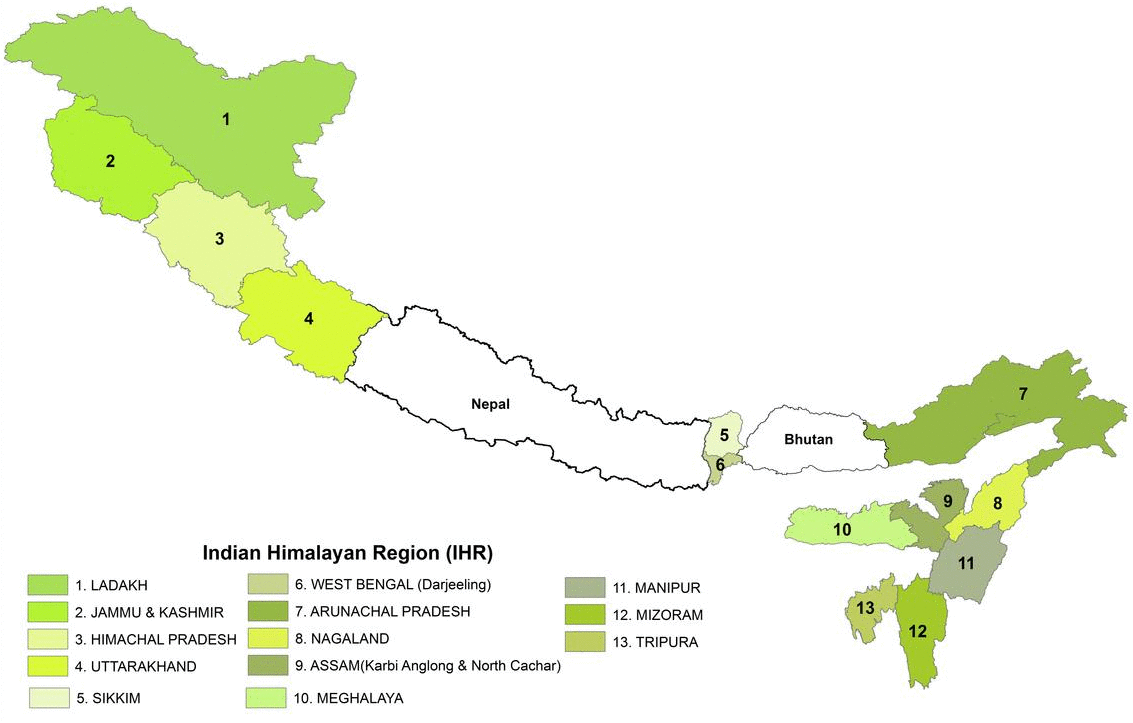Important Facts For Prelims
Carrying Capacity of Himalayan States
- 08 Sep 2023
- 4 min read
Why in News?
The Centre has urged the Supreme Court to direct 13 Himalayan states of the country to assess their 'carrying capacity' and proposed setting up of an expert panel to evaluate the action plans submitted by each of them.
- This initiative is essential to ensure sustainable development and preservation of the fragile Himalayan ecosystem.
What is Carrying Capacity?
- Carrying capacity refers to the maximum population size that an ecosystem or environment can sustainably support over a specific period without causing significant degradation or harm to its natural resources and overall health.
- Carrying capacity assessments is crucial for understanding and managing the balance between human activities and the preservation of natural ecosystems to ensure long-term sustainability.
What are the Government Initiatives Related to the Conservation of the Himalayan Region?
- National Mission on Sustaining Himalayan Ecosystem (2010):
- Covers 11 states (Himachal Pradesh, Uttarakhand, Sikkim, all northeast states, and West Bengal) and 2 UTs (Jammu & Kashmir and Ladakh).
- Part of the National Action Plan on Climate Change (NAPCC), comprising eight missions.
- Indian Himalayas Climate Adaptation Programme (IHCAP):
- It aims to enhance the resilience of vulnerable communities in the Indian Himalayas by strengthening the capacities of Indian institutions in climate science, with a specific focus on glaciology and related areas
- SECURE Himalaya Project:
- Integral to the "Global Partnership on Wildlife Conservation and Crime Prevention for Sustainable Development" (Global Wildlife Program), funded by the Global Environment Facility (GEF).
- Focuses on promoting sustainable management of alpine pastures and forests in the high-range Himalayan ecosystems.
- Mishra Committee Report 1976:
- Named after MC Mishra, the then Garhwal commissioner in erstwhile Uttar Pradesh. It provided findings on land subsidence in Joshimath.
- Recommendations included imposing restrictions on heavy construction work, blasting, excavation for road repairs and other construction activities, and tree felling in the region.
UPSC Civil Services Examination, Previous Year Questions (PYQs)
Prelims:
Q. Consider the following pairs: (2020)
| Peak | Mountains |
| 1. Namcha Barwa | Garhwal Himalaya |
| 2. Nanda Devi | Kumaon Himalaya |
| 3. Nokrek | Sikkim Himalaya |
Which of the pairs given above is/are correctly matched?
(a) 1 and 2
(b) 2 only
(c) 1 and 3
(d) 3 only
Ans: (b)
Q. If you travel through the Himalayas, you are likely to see which of the following plants naturally growing there? (2014)
- Oak
- Rhododendron
- Sandalwood
Select the correct answer using the code given below:
(a) 1 and 2 only
(b) 3 only
(c) 1 and 3 only
(d) 1, 2 and 3
Ans: (a)
Q. When you travel in the Himalayas, you will see the following: (2012)
- Deep gorges
- U-turn river courses
- Parallel mountain ranges
- Steep gradients causing landsliding
Which of the above can be said to be the evidence for Himalayas being young fold mountains?
(a) 1 and 2 only
(b) 1, 2, and 4 only
(c) 3 and 4 only
(d) 1, 2, 3 and 4
Ans: (d)
Mains:
Q. Differentiate the causes of landslides in the Himalayan region and Western Ghats. (2021)
Q. How will the melting of Himalayan glaciers have a far-reaching impact on the water resources of India? (2020)
Q. “The Himalayas are highly prone to landslides.” Discuss the causes and suggest suitable measures of mitigation. (2016)







